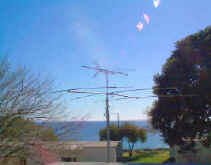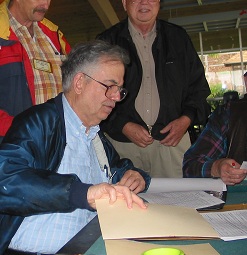Welcome to Handiham World!
In this edition:
New net will be on 75 m
Band plan isn't the same as frequency chart
Dip in the pool
NASA internships available for students with disabilities
Launch date set for Discovery mission
Putting in a speech module proves to be quite a chore
K1RFD puts in a guest appearance on TIPSnet
This week at HQ
It's time for a new HF net - Part 3
![]()
Two weeks ago we said : We need at least consider moving our HF net to 160, 75, or 40 meters, and those bands are likely to be most useful in the evening. Because 160 requires a very long antenna, it is impractical for many users. 40 can get crowded, but requires the shortest antenna of the three. Of course we can consider reviving our 17 meter "non-net roundtable", which was originally started by Alan, K2WS, but the sun will have to spit out a few more spots for that band to get where it needs to be. So what do you think? 160? 75? 40? Or something else? And what about the time and day?
Decision time is here! we really need to get moving on this new net, and the consensus seems to be building around 75 m as the best band. Therefore, we will proceed to the next step, which is choosing a net frequency. Most of the responses I have gotten indicate that users would prefer a frequency in the Extra or Advanced class portions of the phone band. We were reminded by one respondent about the "DX window" in the ARRL band plan, which is 3.790 to 3.800 MHz. The Extra portion of the band runs from 3.600 to 3.700 MHz. The Advanced portion runs from 3.700 to 3.800 MHz. The General portion runs from 3.800 MHz to the top of the band at 4.000 MHz. All General frequencies are available to Advanced and Extra licensees, of course.
So the next step is to start listening in the evening for clear frequencies. Please report the frequency and the time you listened along with the day of the week so that we can pick a mostly clear spot for a regular weekly net. By the way, the net does not have to be weekly – it could be daily, a couple of times a week, or whatever Handiham Radio Club members think is appropriate and reasonable. Send your reports to me over the coming week so that we can move on to the next step and get the word out about our new 75 m net.
By the way, there are no plans to make this a formal traffic net or anything like that. While I wouldn't rule out the possibility of handling traffic, I think it would be fun to just have a nice social net on HF during the long winter evenings. As with the daily EchoLink net, we could enlist net control stations or simply have a more or less uncontrolled roundtable gathering. Maybe we will have some of both, depending on who shows up to join in the fun!
Please e-mail me this week with your frequency and time suggestions, frequency reports, and other suggestions about the net.
73,
Patrick Tice, WA0TDA
Handiham Manager
wa0tda@arrl.net




